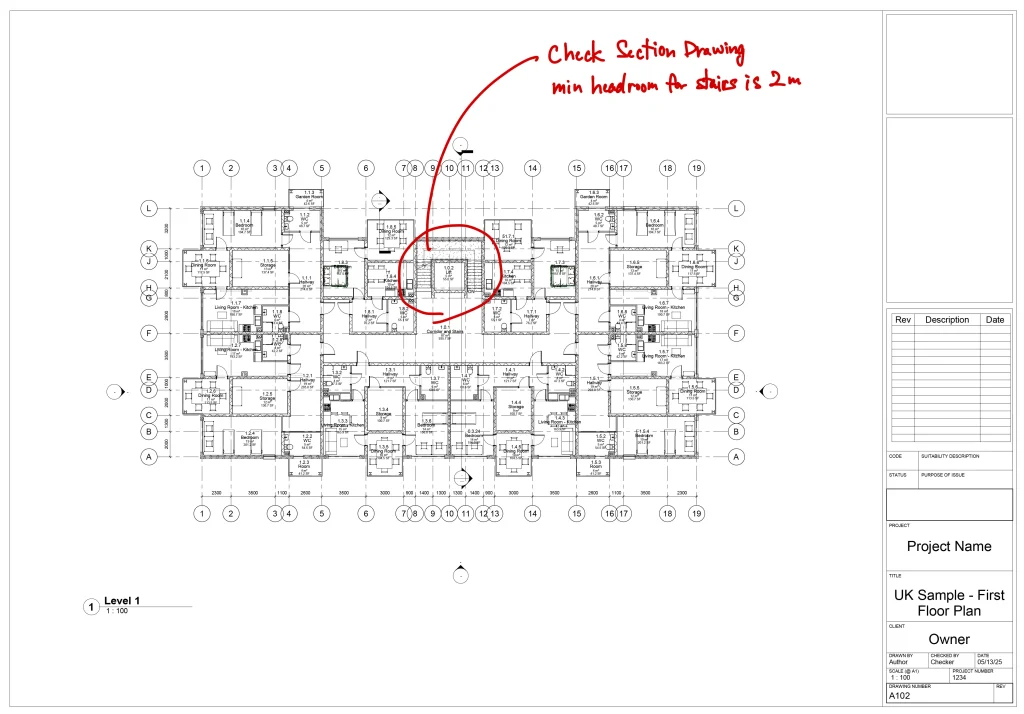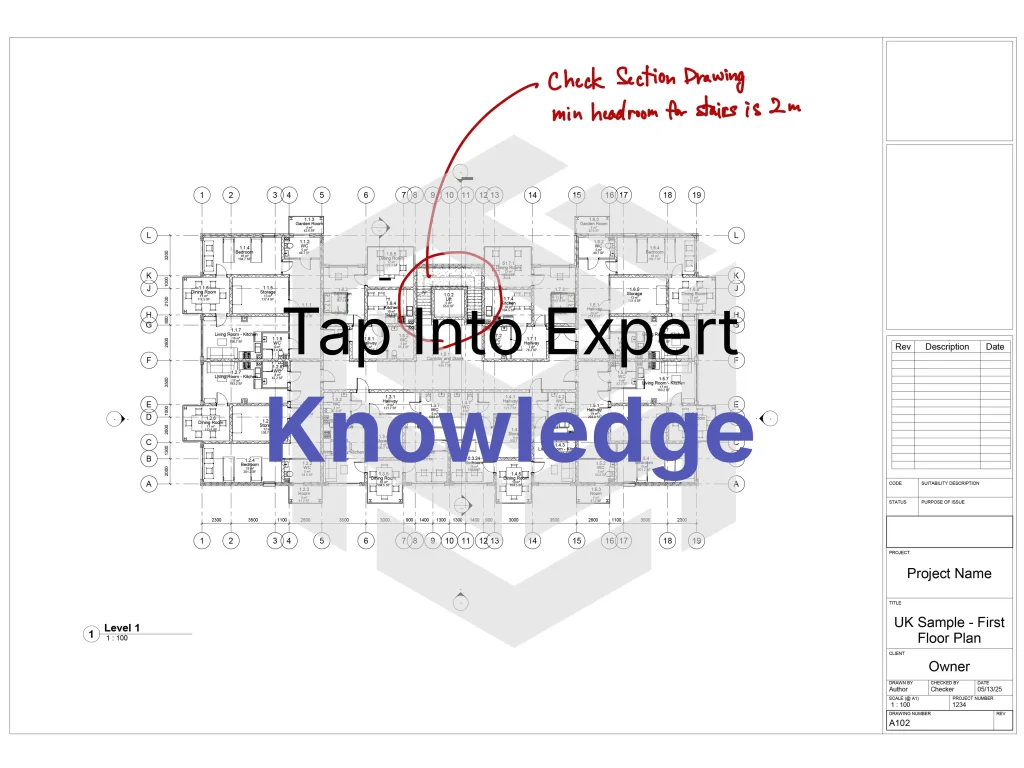Every architectural project generates a wealth of markups yet much of this wisdom is forgotten once the project wraps up. As one architect put it, “we discovered that it’s hard to find information on particularly what works and what doesn’t” in previous project documents according to Metropolis Mag. The valuable feedback captured in drawings and PDFs often lives in a digital attic, inaccessible to the people who need it. The result? Teams unwittingly repeat mistakes or “reinvent the wheel” because they can’t tap into past lessons.
In this article, we’ll explore why drawing markups hold untapped knowledge and how Tektome’s KnowledgeBuilder helps unlock it.
Why Drawing Markups Hold Untapped Knowledge

Architects and engineers don’t just produce drawings – they mark them up with expert feedback. Whether it’s a senior architect’s correction on a detail or a reviewer’s redlined comment about a design flaw, these markups encapsulate practical lessons learned on the job. Over the course of a project, countless issues are identified and solved in these annotations. However, once the project is completed, those annotated prints or PDF comments usually get filed away and rarely see the light of day again.
Valuable knowledge remains locked in project archives, creating a “knowledge blind spot” for the firm. Teams struggle to retrieve past insights, so the hard-won wisdom from one project often fails to inform the next.
Why does this matter? Because ignoring past markups means missing out on expert guidance. Those comments and redlines were essentially mini lessons: notes on what to fix, what to avoid, and why. If this knowledge isn’t easily accessible later, even seasoned professionals might repeat earlier errors simply because they didn’t recall that it had been flagged before. For newer architects who weren’t on the original project, the insights in those markups might as well not exist if there’s no way to find them. Clearly, there’s huge value in making this buried expertise searchable and referenceable.
Avoiding Recurring Mistakes with KnowledgeBuilder
This is where KnowledgeBuilder steps in. Tektome’s KnowledgeBuilder uses AI to dig through all those past markups, notes, and drawings and highlight the lessons they contain. One of the biggest benefits is how it identifies recurring mistakes across projects so future teams can avoid them. By processing decades of drawings (yes, even scanned sketches and handwritten redlines), KnowledgeBuilder can spot patterns – for example, perhaps multiple projects had issues with a certain roof detail or regulation compliance error. Armed with that information, architects can proactively prevent those common quality issues instead of stumbling into the same pitfalls again. As the platform automatically surfaces these documented challenges and past fixes, teams gain a sort of “corporate memory” of what not to do.
Consider a real example: a construction firm that used KnowledgeBuilder found it kept encountering roof waterproofing problems. After indexing their past mark-ups, the system revealed frequent notes by senior architects about waterproofing mistakes on various jobs. This insight allowed the firm to address the root cause and update their standards, so new projects wouldn’t suffer the same leaks. The ability to learn from past redline comments means less rework and fewer on-site surprises.
Learning from Senior Architects’ Annotations (Bridging the Experience Gap)
Another powerful aspect of unlocking markup data is how it bridges the experience gap between veteran architects and junior staff. In many firms, the most valuable lessons live in the heads (and scribbles) of senior architects. A redline note on a drawing might reflect 30 years of experience – perhaps a savvy detail to resolve a tricky intersection or a caution about a material choice. Normally, a junior architect might never see that note if they weren’t part of the original project team. But by making all those past annotations searchable, KnowledgeBuilder allows anyone in the firm to tap into the “experienced know-how” of veteran staff.
For example, if a junior designer is detailing a facade and wonders about thermal bridging, they could search the knowledge base and pull up past markups on insulation or condensation issues that senior architects had noted. It’s like having decades of firm-wide feedback at your fingertips. This not only prevents mistakes but also accelerates learning.
In practice, KnowledgeBuilder makes a senior architect’s handwritten red-line notes on an old print as accessible as today’s BIM comment – ensuring that veteran wisdom is never more than a quick search away.
Turning Markups into Actionable Knowledge
How exactly does KnowledgeBuilder convert messy markups into something you can use? The platform leverages state-of-the-art AI (including language processing and OCR) to read and organise the content of your project files. This means it can scan through PDFs of drawings, even if they contain handwritten annotations or scanned sketches, and pull out the meaningful information.
Comments and redline texts that were once just static scribbles are transformed into searchable data. KnowledgeBuilder essentially builds a structured index of all your past project documents, from files and meeting notes to site photos and markups, so you can query it like a living library of design knowledge.
The key is that all this information is organised contextually. You’re not just getting a random dump of text from drawings; KnowledgeBuilder tags and links data by project, topic, and attribute. For instance, it can categorise markups by the drawing sheet, date, author, or issue type, etc.
When you start a new project, you can easily reference these historical notes. Suppose you recall that someone had commented about a particular HVAC layout in a previous job – instead of combing through old PDFs manually, you can ask the system in plain English.
The AI understands architectural terminology, so a query like “show past redline comments on fire exit layouts” or “find notes about foundation cracks” will fetch relevant results even if the wording in the markups varies.
Crucially, the platform doesn’t just find information – it makes it actionable. By aggregating similar notes, it can point you to common solutions and best practices in the Summary. Those old redlines become lessons learned checklists for your new project. You can quickly see, for example, all the field notes about concrete floor cracking and then ensure your current design addresses those concerns. This way, past markups become guidance for future success, rather than fading into dusty archives.
Leveraging Past Feedback to Save Time and Improve Outcomes
Making markup knowledge accessible yields real benefits in day-to-day practice.
- Time savings. Think of how long it used to take to dig through old project folders (assuming you even knew where to look). With a smart search tool, what once took hours of rummaging through binders or network drives can now be done in minutes or seconds. Architects can spend more time designing and less time playing detective in the file storage. Quick access to past solutions also means teams can respond faster to design challenges – you don’t have to start from scratch when you likely already solved a similar issue five years ago.
- Quality and error reduction. By consulting the collective feedback from dozens of past projects, architects are far less likely to repeat mistakes. Common pitfalls come flagged with big red arrows (sometimes literally, in the markups!), allowing teams to sidestep those traps. As noted earlier, this can save substantial rework and cost. The outcome is a smoother project with fewer last-minute scrambles to fix avoidable problems.
- Consistency and continuous improvement. Over time, feeding lessons from markups back into current practices creates a virtuous cycle of learning. Firms can update their standards and checklists based on real-world feedback captured by KnowledgeBuilder. This leads to better outcomes for clients as well – designs are refined by the accumulated experience of many projects, not just the limited knowledge of the current team.
- Innovation. Having a rich database of past ideas and solutions can spark new approaches. Perhaps a clever detail from a past project inspires a creative twist in your new design.
Summary
Drawing markups are gold mines of expert feedback that too often go underutilised. Every red line and comment on a plan is a lesson someone took the time to document. Tektome’s KnowledgeBuilder unlocks this trove of knowledge, making it easy to search and learn from past annotations. By tapping into these insights, architects can avoid repeating mistakes, train newcomers with real examples, and deliver projects with greater confidence and quality.
Interested in putting your firm’s past knowledge to work? KnowledgeBuilder turns yesterday’s markups into today’s best practices. By adopting a tool that connects you to decades of expertise, you empower your team to work smarter, not harder.
To see how it works in action, visit Tektome’s KnowledgeBuilder page and schedule a demo with us.

